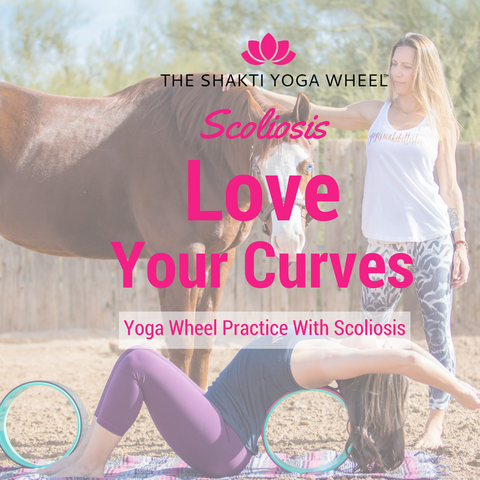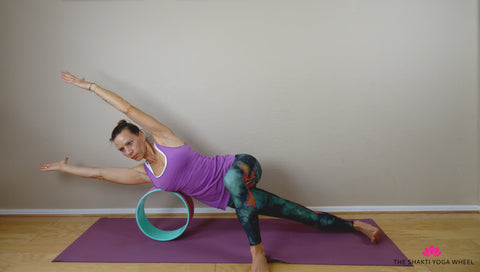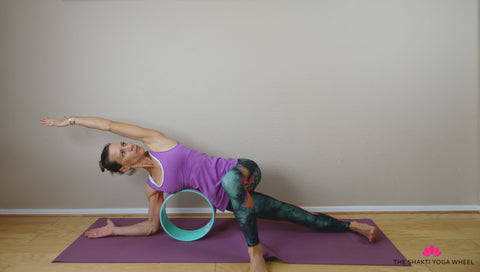Love Your Curves: Yoga Wheel Practice With Scoliosis

Scoliosis affects 6 million Americans.
According to The National Scoliosis Foundation, scoliosis affects both genders, and its onset typically occurs between the ages of 10 and 15. Treatment includes bracing, and in more advanced cases, surgery. Though mild scoliosis often presents few symptoms, severe forms may limit lung capacity, place pressure on the heart, and reduce overall range and quality of physical movement.
"While scoliosis can be caused by conditions such as cerebral palsy and muscular dystrophy, the cause of most scoliosis is unknown.”
Practicing yoga with Scoliosis.
“Finding alignment” in an asymmetrical frame can be challenging if you don’t have an experienced yoga teacher. But modifications can make it work, and it is possible to feel at home in a pain-free body. A scoliosis-type curve can be anywhere in the spine and can sometimes result in a compensatory “counter curve” (i.e., an S-curve).
Ask your primary care provider to do a musculoskeletal exam on you and tell you if your curve is more predominant in the thoracic or lumbar region. Understand that scoliosis can cause other physical nuances (one shoulder sitting higher than the other, one hip lower than the other, etc.).
Depending on your degree of curvature, some physical therapy might be indicated before beginning an exercise regimen like yoga.
With Shakti Yoga & The Shakti Yoga Wheel® method, we teach how to elongate the spine so you can apply those techniques in your day to day life and passive positions such as sitting or lying as well. It is an active technique that is using the inner corset. The use of the yoga wheel and exploring the elongation changes the shape of the scoliotic curves in the spine and puts a positive stressor on the bones and muscles allowing them to change positively. For most of our students, this quickly translated to less pain and, over time, they can feel the changes in the muscles on either side of the spine.
The method also teaches the change of the pelvic position from tucked to anteverted which takes a lot of pressure off of the disc at L5-S1. A tucked position is a default for most of the people and creates a lot of stiffness around that joint.
These yoga postures can help you to strengthen your muscles to balance out the a-symmetry of scoliosis. When looking for the modification try to reflect on the essence of the pose. Rather than focusing only on what the pose looks like. We think it’s far more important to know what the pose feels like from the inside, and the energetics that results from the specific geometry of the pose.
Parivrtta Upavistha Konasana
Start with Parivrtta Upavistha Konasana (revolved seated angle pose). It’s an asana you’ll move into slowly and progress with gradually. Modifying to your level along the way makes it an even greater “value.” If you are currently pregnant or experiencing back pain, a simple side reach (not catching hold of the foot) in a wide Upvistha Konasana is best for now. It's generally recommended that those with C-curve scoliosis stretch the concave (shorter/tighter) side of the body longer than the convex side (the side that's rounded outward). This also applies for those who don't have scoliosis and are simply tighter on one side of the body than they are on the other.

Side Plank Variations

Place the yoga wheel on your rib cage and step the top foot in front of you. Lift the hip and the arms and lengthen the crown of your head away from your left heel. Lengthen the right side of your rib cage from the hip to the armpit. Observe any differences in the two sides of your spine. You can continue to look straight ahead, or you can turn your head to look up toward your top hand if that feels comfortable for your neck. Stay for thirty seconds, or longer if comfortable. Then return to all fours and repeat on the second side.

Place the yoga wheel at your lower rib cage region, almost at your waist, so the wheel is helping you to deepen the side stretch. Stack the lower shoulder above your elbow and turn the palm up to lift the inner shoulder and press into your forearm and away from the floor.
In Dr. Fishman's study, students with scoliosis practiced only with their convex side facing the floor so as not to do anything to reinforce their existing imbalance. If you have scoliosis, try working on only one side. Otherwise, practice on both sides, but do pay close attention to the sensations on either side. Does practicing on one side feel easier than it does on the other? The differences may not be entirely in your spine—for example, is one shoulder tighter, or is one hip more mobile than the other? What can your stronger side teach your weaker side?
If you would like to learn more about the Shakti Yoga Wheel® Method, check out workshops, classes, and teacher training.
Leave us a comment! The best things happen in the discussions below!
1 comment
Would this be for an older female with scoliosis?
